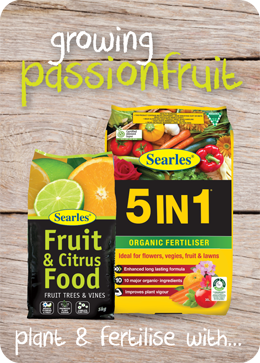Planting and growing Passionfruit vines
 |
|
Passionfruit is a lovely subtropical vine which ticks all the boxes for suitability, producibility and beauty for home gardens. It’s quick, lush growing manner is often an ideal choice for covering unsightly fences and walls and let us not fail to mention its fruits are a gift to us from the Gods.
Planting passionfruitEven though passionfruit vines ideally grow in warm temperate and sub-tropical climates, they will happily grow and fruit in cooler areas if planted in a warm sunny spot, preferably on a North facing wall which will provide warmth and protection from frost. Nellie Kelly is a popular variety for cooler climates. Plant new vines in a sunny, sheltered position during the warmer months from Spring to early Autumn to help settle the roots and establish new growth. You will need to wait for the next season or two after planting before they will bear fruit. Support their growth and developing fruit by anchoring them along a fence, up a pergola or trellis which they will quickly cover.
Before planting prepare the soil with 5 IN 1 Organic Fertiliser to enrich the soil with plenty of compost and nutrients essential for their vigorous growth of foliage and fruit development.
After planting passionfruit, water soil deeply and mulch over their shallow root system to protect their roots from soil temperature fluctuations, weeds and help retain soil moisture.
Passionfruit vines produce their best crops in the first 3 to 5 years. If your vine is looking tired and old, it is time to plant a new one.
Watering PassionfruitPassionfruit vines require regular watering, especially on the approach of fruit maturity. Irregular watering regime will result in poor flowering or fruit dropping prematurely.
Fertilising Passionfruit VinesFertilise passionfruit vines from early Spring when they start to flower with an application of Searles Fruit & Citrus Plant Food every season until the end of Autumn. Once the fruit is developing, additionally feed every fortnight with Searles Flourish Fruit Booster to increase nutrients for proper development of pulp inside the fruit. As the vine roots extend to support its growth, fertilise to the far reach of its root system.
Harvesting PassionfruitFor the best-tasting fruit, leave the fruit on the vine to ripen until the fruit falls off. Bag the fruits with a produce netting to keep the insects from harvesting them before you do.
Poor fruit set of passionfruitThe most common problem passionfruit gardeners have to contend with is no flowers, or the vine is flowering but not fruiting.
Passionfruit is not flowering – Passionfruit vines are hungry feeders and need fertilising, especially with high potash (potassium) content fertiliser. Searles Fruit & Citrus Plant Food and Searles Flourish Fruit Booster both have high potassium amounts to boost blooms. High wind, drought, lack of water, frost and pruning at the wrong time will also affect flowering.
Passionfruit is flowering but not fruiting – Again, check the main offenders, wind, water, insects and frost. After eliminating these factors, the lack of pollination from bees, maybe the problem. Encourage bees to naturally frequent your garden by planting flowering plants near your vine. Any flowering plants will be of benefit, particularly lavender. If this fails, hand-pollinating with the use of a small paintbrush will help nature along. To hand pollinate, stroke the stamen downwards to collect pollen and transfer the pollen to another flower’s stigma. Do this early morning and repeat process until fruit starts forming. Some varieties require a second vine to provide cross-pollination naturally, but the popular varieties 'Nellie Kelly' and the 'Panama Gold' series are self-fertile.
Pruning PassionfruitCut back vines late winter to early Spring if you need to control its size. Cut back smaller twining stems, leaving the primary stems alone.
Pests & Diseases of PassionfruitWatch out for pests and diseases as large infestations can lead to reduced flowering or fruit drop. Fruit Fly spoil your whole crop by stinging the fruit and causing it to rot. Look for pinprick holes and hard lumps on the fruit. Fruit Fly are in more significant numbers during the warmer months of the year. Install fruit fly trap around the perimeter of the vine to attract and kill the male flies. Passionfruit vine hopper is a moth-like insect which can cause leaf damage and fruit drop. Like scale which also affects passionfruit vines, the hoppers leave sticky honeydew secretions behind that sooty mould grow on, and the ants love too. Treat hoppers with Searles Bug Beater Natural Pyrethrum spray and scale with Searles Pest Gun. Crinkled, yellowing leaf growth and poor fruit development could be a sign of the Passionfruit Woodiness Virus. Healthy and well-fertilised vines are generally not affected by this virus. There is no cure. If the vine is old, plant a new vine. Fungal diseases such as Brown spot, Septoria spot appear as brown spots with a yellow outer ring on passionfruit leaves and fruit. Remove affected fruit and leaves and treat the remaining vine with Searles Copper Oxychloride. |
---------------------------------
|





